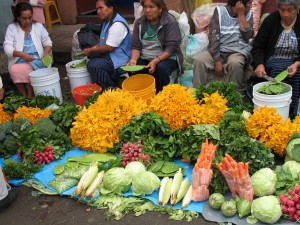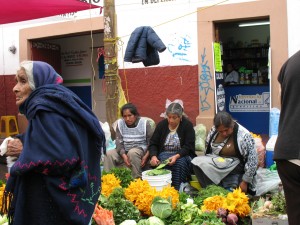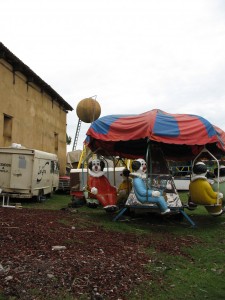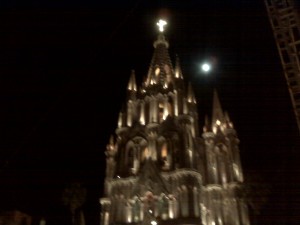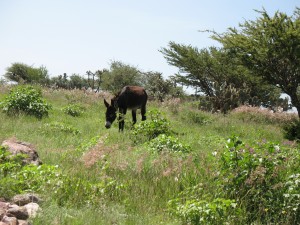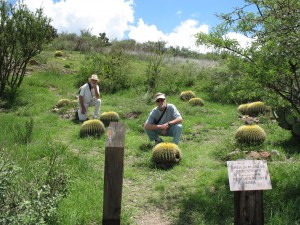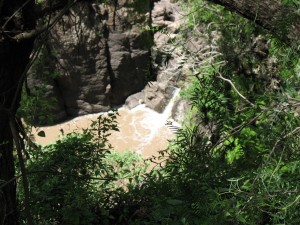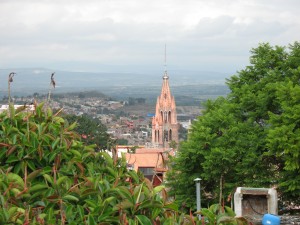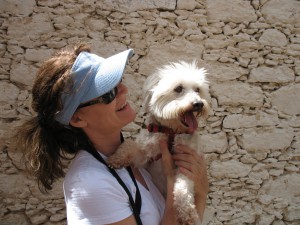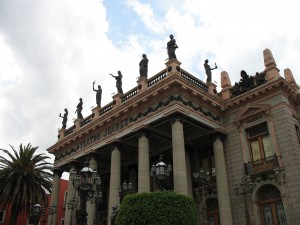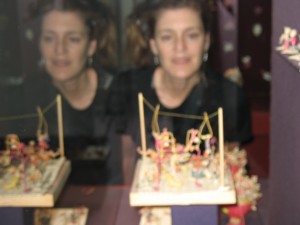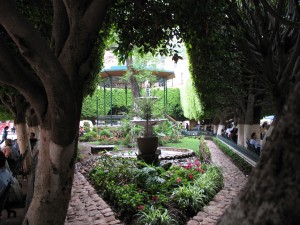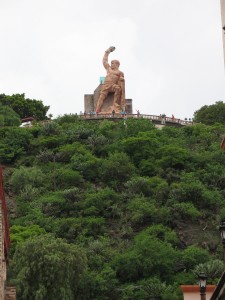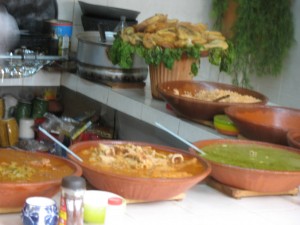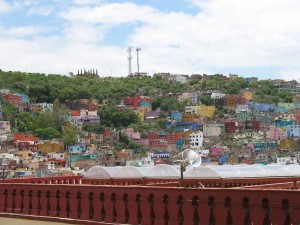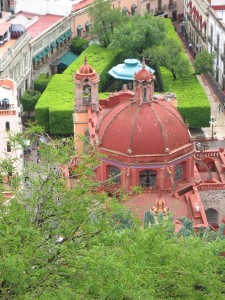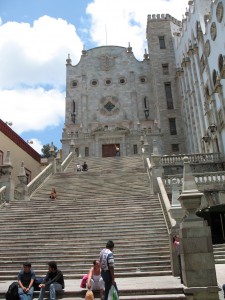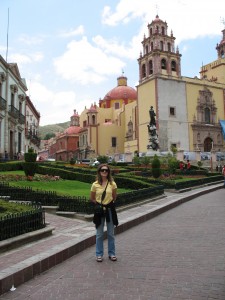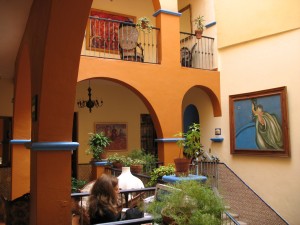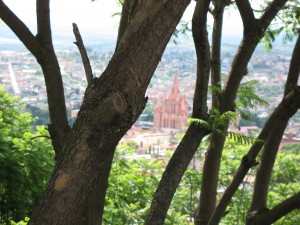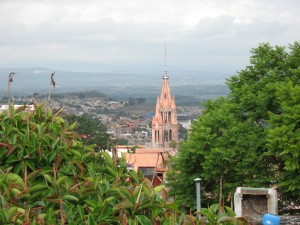Morgan did the 6 ½ hour drive in Jimâs car from San Miguel through the hills to PĂĄtzcuaro and what a relief (because Morgan is a great driver and JimâŚwhew! is unconscious). The landscape is breathtaking, verdant, gorgeous, not at all what any of us expected. Vacas (cows) and burros and caballos (horses) graze scattered throughout the hills, rarely fenced, but sometimes tethered on a long rope. They are healthy and fit and handsome animals here.
And here’s this great library with a history of all of Mexico in this mural.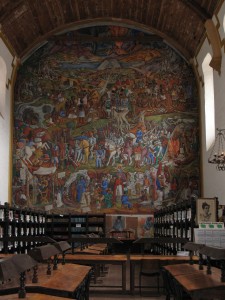
Â
The indigenas (indigenous people) of PĂĄtzcuaro in the state of MichoacĂĄn, are the originators of el Dia de Muertos, October 31- November 2. Their old âpaganâ beliefs where a world of the dead parallels that of the living, combines with Catholicism (brought by the Spanish Jesuits) to create Mexican Catholicism. They say PĂĄtzcuaro is utterly packed with Mexicans at that time. And by the way, we never met a single American while here in Patz.
Â
Found a fine little hotel, thanks to Lonely Planet guidebook, off el centro, Posada de los Angeles, for $40.
We planned to be there for their huge Friday Market, and so glad we were. I took a load of photos, clandestinely, as the people donât like to be photographed. Mostly I shot pyramids of perfect tomatoes, greens, cilantro, saffron-yellow squash blossoms, figs, avocados, mangos. 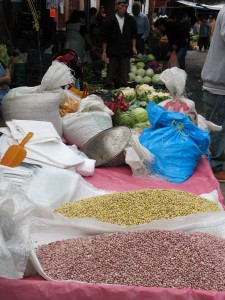
Â
And then we set offâwith Jim driving — to circle the big lake, to see small Indian villages and artesanian work.
We stop at the village of Tocuaro where they carve red cedar statues, mostly of the saints. This is Catholic country, where the Virgin of Guadalupe is the patron saint. Of all Mexico. Eventually weâre in pine forests, in horse country. Handsome horses graze everywhere, men ride, reminding us that to the Indians the conquistadors on horseback looked like two-headed monsters.
We enter the village of Jaracuaro. On the city wall is written, ciudad con colera–city with cholera. We pay no heed, but itâs a ghostly townâno hustle and bustle. Our Toyota Highlander can barely make it down the narrow streets, but this is not unusual. We go for the parrochia, (church) which is always the center of town. Itâs a large deserted square with an electrified but sleeping carnival at its edge. This is surrealâthe twilight zone. We clear out. Jim loved it. Not us.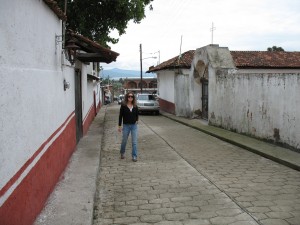
Â
We were given this small simple tourist map labeled with all indio names. My job as navigator was a little odd, as few of the actual villages had the names that matched the map. So we were cruising through land that looks more like Ireland–green hills, mountains in the distanceâwondering (is this the road weâre on?–Durwood) and Jim is driving all over the curving mountain roads, crossing the dividing line and an oncoming car rounds a curve and is coming straight for us. I say, âI think it would be best to stay in our lane.â Further on weâre tooling along at a clip on some straightaway and Jim says, âI donât know where weâre going, but weâre making great time.â We do a lot of laughing. We eventually realize that, since we could occasionally see the lake from the mountainside, we must be going the right route.
But there’s the moment when we’re quite confused and decide to ask for directions. In a tiny village we approach and stop behind a group of men surrounding a parked car. I lean out the window and say, “Buenas tardes. Por favor, nos pueden decir donde…” and ole chivalrous Jim yells, “Get out of the car.” In alarm, I stumble out of the car still questioning the Mexicans and one guy comes to lean in our window (with me outside with him) because surely no woman is smart enough to handle this, but the Mexican realizes that no one in the car can speak to him, and eventually we realize that this cat doesn’t have any idea how to locate us on our pathetic map. “Donde esta el luego?” I ask. “Cual luego?” which isn’t promising. Okay, so I get back in the car and say, “Jim!” “Well,” he says, “you can’t expect him to come to us.” And I tell him there are different rules for women. So anyway, this becomes sort of standing joke for the rest of the trip. “Get out of the car,” when he orders dinner at a restaurant instead of deferring to me, THE WOMAN. Okay, good thing it’s all good natured. We just laugh.
Â
â[Weâre] not lost, just confused.â Credited to Davy Crocket or Daniel Boone, via Jim Lewis.
Â
We veer off the lake because weâve been told that Capula, on the way to Morelia, is where you find Catrinas. Traditional Calvera Catrinas, are part of the Day of the Dead celebration, part of the playfulness that Mexicans associate with death. These skeletal figures, women in low-cut flowery dresses, often seductively display one leg (or femur bone thereof) and don an outrageous flowered hat on her bobbling head. It bobbles because itâs detachable. Sometimes theyâre dancing, but always cheerfully peering out of a skull with cavernous eye sockets and grinning horribly. The best have attitude to the hilt–cheeky skeletal broads. We find them quite beautiful, especially those created in ceramic by the artist Mariana Xhenhuaro. You can find many mass-produced varieties, but Marianaâs are one of kind. They were scattered around her tiny store/studio, attached to her house, in various degrees of completionânot yet fired, headless, unpainted, half-painted.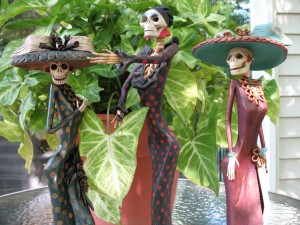
Â
She also makes beautiful ceramic dish sets–one of a kind. Weâd love to have them, but 1) we donât need them and 2) the whole set weighs about a ton, but they sure are gorgeous.
Â
We pick up a hippy-looking coupleâshe with long blond dreads and he with brown. A handsome couple of kids, she from Holland, he from Italy. They smell like hell, but they sure are interesting and lovely. Theyâre mostly taking buses around the country on the grand adventure.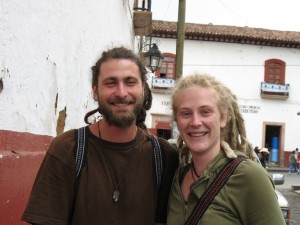
Â
We drive back to PĂĄtzcuaro, drop off our hitchhikers, and eat a fine dinner at La Puerta Roja, spend the second night in our hotel. From the roof, we watched the moon rise. And set off for home (San Miguel) the next day. We go through fewer cities on the way home and itâs much quicker, but we still must go through some towns and cities. At the traffic light, a band of boys pops out of nowhere and clean our windshield, hoping for pesos–hich, of course, we give them. There are also jugglers, clowns, venders of every sort at every traffic light, in want of pesos. (Even when walking down the streets Morgan and I keep pesos at the ready and give to all who askâ2, 5, or 10, whatever weâve got. Weâre especially drawn to the indios, more correctly called indigenas).
Â
There are far fewer traffic lights in Mexican cities than U.S. Trucks and cars just nudge their way into traffic, the main stream generously giving way. Iâm reminded of a report Iâd heard on PBS about scientists studying ant behavior in order to try to improve traffic patterns. Ants actually bump into each other, nudging each other, to negotiate right-of-way. I think the Mexican personality is better suited to this efficient friendly antlike behavior. Itâs like Italian traffic, but in Italy they like to yell and honk. Not so, in Mexico.
Â
We made much better time coming home. And itâs good to be home. Tonight weâll go to Mama Miaâs to hear the Andean band, which we love, and throw a party Sunday for our new friends here. And then, Iâm ready to come all the way home.Â
Â
